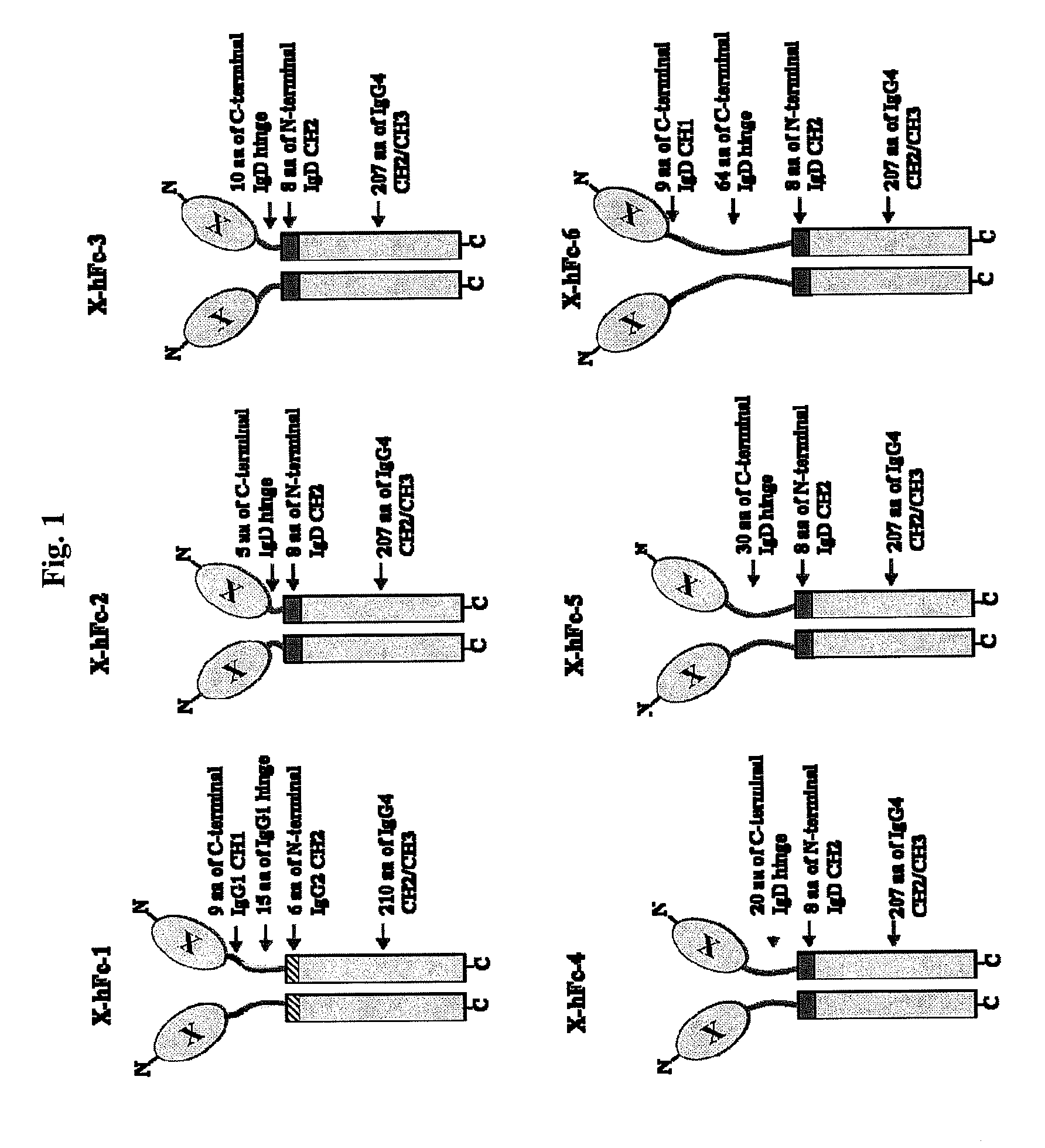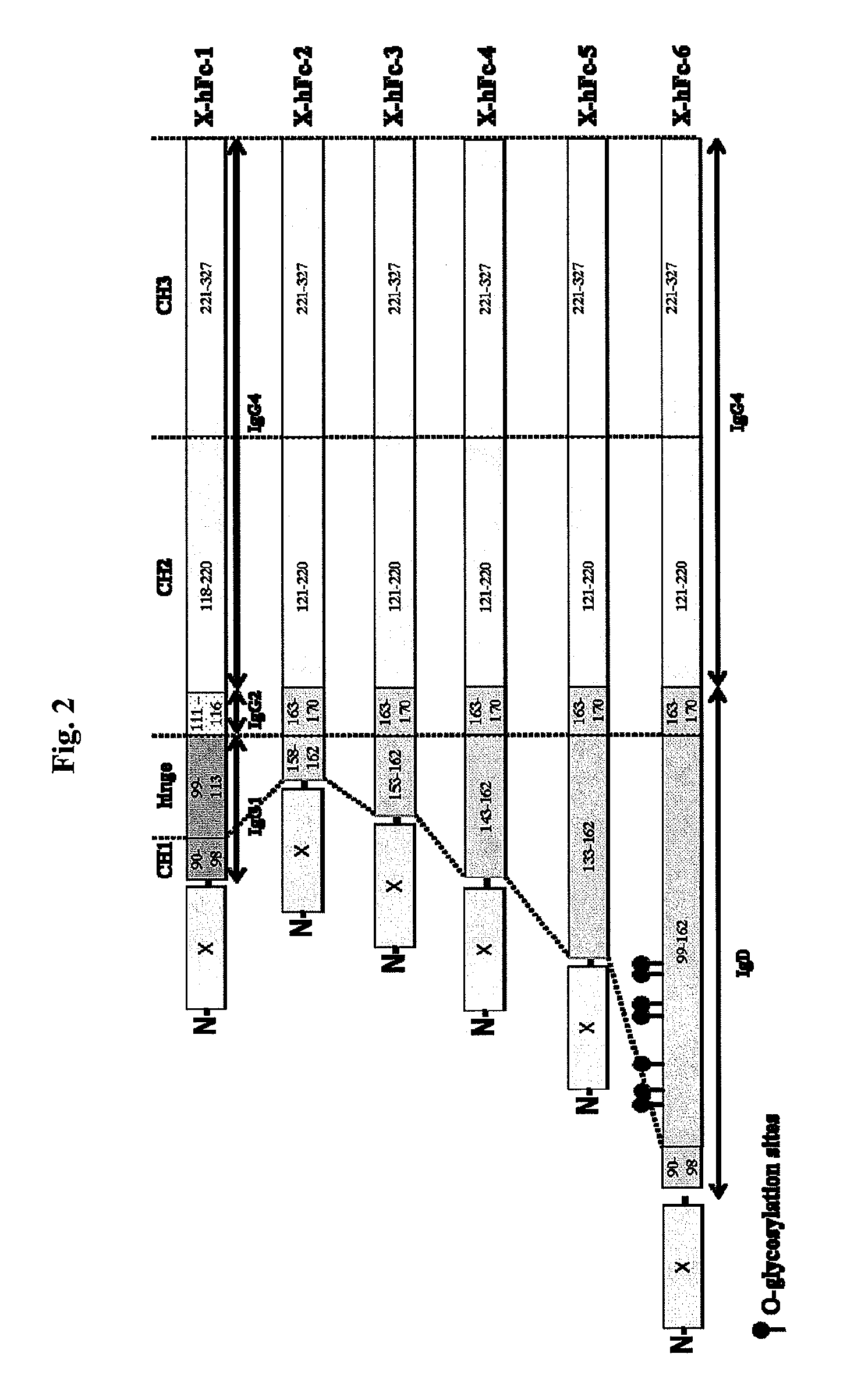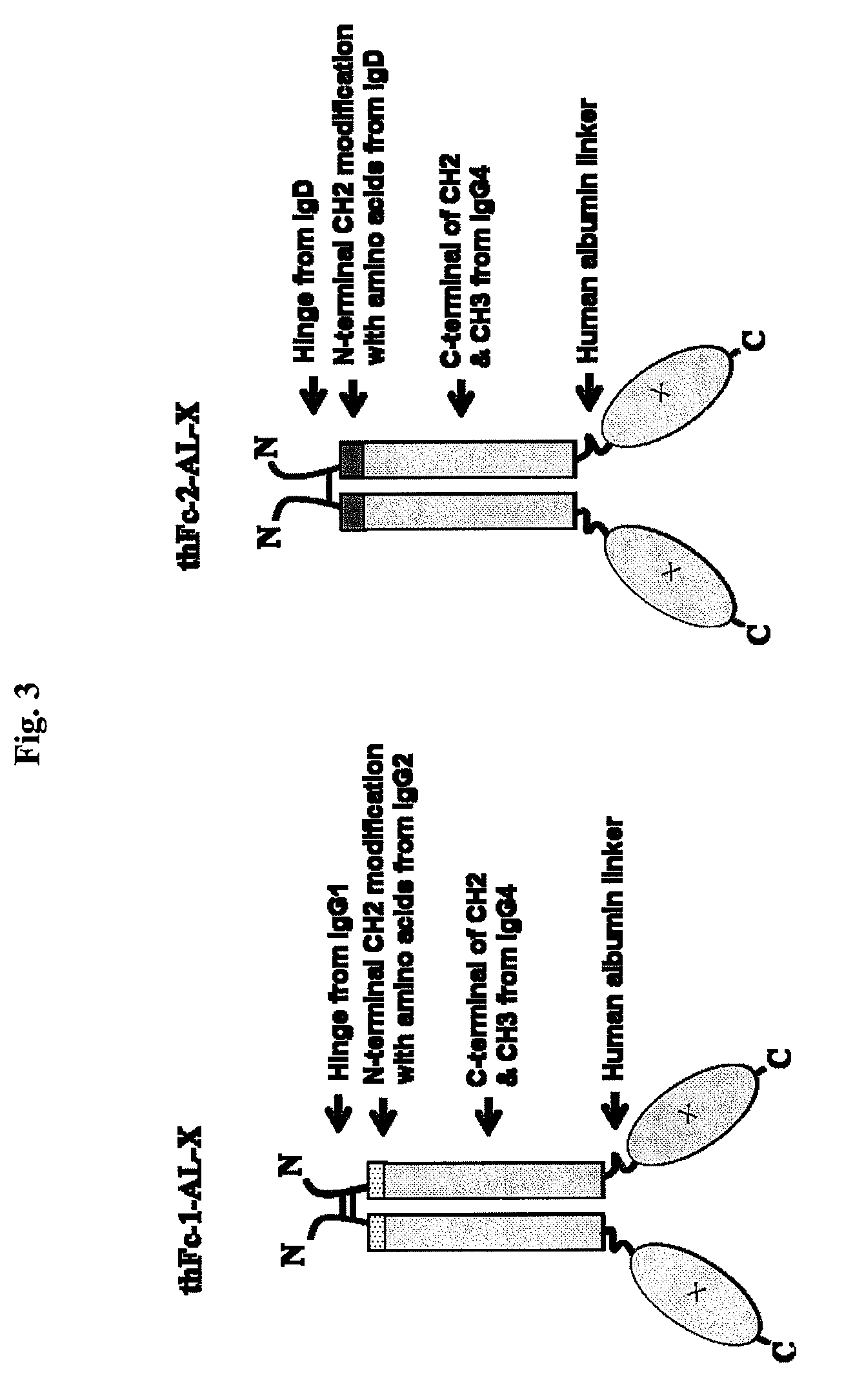Immunoglobulin fusion proteins
a technology of immunoglobulin and fusion protein, which is applied in the direction of fusion polypeptide, peptide/protein ingredients, dna/rna fragmentation, etc., can solve the problems of ineffective method to develop effective pharmaceutical formulations containing active proteins, decrease of protein bioactivity, and low in vivo stability, so as to reduce the risk of undesired immune response and minimal loss of biological activity
- Summary
- Abstract
- Description
- Claims
- Application Information
AI Technical Summary
Benefits of technology
Problems solved by technology
Method used
Image
Examples
example 1
Preparation of Expression Vectors for hFc-1, hFc-2, hFc-3, hFc-4, hFc-5, and hFc-6 Fusion Proteins
The hFc-1 includes 9 amino acids (90-98) of C-terminal IgG1 CH1 region, hinge region (99-113) of IgG1, 6 amino acids (111-116) of N-terminal IgG2 CH2 region, 103 amino acids (118-220) of IgG4 CH2 region, and 107 amino acids (221-327) of IgG4 CH3 region (FIGS. 1 and 2). An amino acid sequence of hFc-1 is shown in SEQ ID NO: 18. To obtain codon-optimized nucleotides each coding for hFc-1 (SEQ ID NO: 1), human EPO (SEQ ID NO: 7), human G-CSF (SEQ ID NO: 8) and human p40N303Q (a mutant derived from substitution of Asn with Gln at the 303rd amino acid of human p40 subunit) (a nucleotide sequence of p40N303Q is shown as SEQ ID NO: 9, and an amino acid sequence of human p40 is shown as SEQ ID NO: 17), respectively, these nucleotide molecules were synthesized by custom service of TOP Gene Technologies (Quebec, Canada) (www.topgenetech.com). To increase the level of protein expression, it is ver...
example 2
Preparation of Expression Vectors for thFc-1 and thFc-2 Coupled to IFN-β
The thFc-1 includes 23 amino acids (MDAMLRGLCCVLLLCGAVFVSPS) of signal sequence of human tissue plasminogen activator (tPA), 15 amino acids (99-113) of IgG1 hinge region, 6 amino acids (111-116) of N-terminal IgG2 CH2 region, 103 amino acids (118-220) of IgG4 CH2 region, and 107 amino acids (221-327) of IgG4 CH3 region (FIG. 3). An amino acid sequence of thFc-1 is shown in SEQ ID NO: 28. The thFc-2 includes 23 amino acids (MDAMLRGLCCVLLLCGAVFVSPS) of tPA signal sequence, 15 amino acids (148-162) of IgD hinge region, 8 amino acids (163-170) of N-terminal IgD CH2 region, 100 amino acids (121-220) of IgG4 CH2 region, and 107 amino acids (221-327) of IgG4 CH3 region (FIG. 3). An amino acid sequence of thFc-2 is shown in SEQ ID NO: 29. To obtain codon-optimized nucleotides coding for thFc-1 (SEQ ID NO: 26) or thFc-2 (SEQ ID NO: 27) coupled to the N-terminus of human IFN-beta deleted its signal sequence, these nucleot...
example 3
Expression of Human EPO-hFcs, Human G-CSF-hFcs, Human p40N303Q-hFcs, Human TNFR-hFc-5 and thFcs-IFN-beta Proteins
COS-7 cells were used for expression test and cultured with DMEM media (Invitrogen, Carlsbad) supplemented with 10% fetal bovine serum (Hyclone, South Logan) and antibiotics (Invitrogen, Carlsbad). The vectors encoding EPO-hFcs, G-CSF-hFcs, p40N303Q-hFcs, TNFR-hFc-5, thFcs-IFN-beta were transfected to 5×106 COS-7 cells using conventional electroporation methods. At 48 h after transfection, supernatants and cells were harvested. To check the expression of fusion protein from each vector, all the samples were used for ELISA assay with several kits (R&D system, Minneapolis, #DEP00 for EPO; Biosource, Camarillo, #KHC2032, for G-CSF; R&D system, Minneapolis, #DY1240 for p40N303Q; R&D system, Minneapolis, #DRT200 for TNFR, PBL Biomedical Laboratories, #41410-1A for IFN-beta) and western blot analysis with anti-human IgG antibodies (Santa Cruz Biotechnology, Santa Cruz). As a re...
PUM
| Property | Measurement | Unit |
|---|---|---|
| pH | aaaaa | aaaaa |
| pH | aaaaa | aaaaa |
| half life | aaaaa | aaaaa |
Abstract
Description
Claims
Application Information
 Login to View More
Login to View More - R&D
- Intellectual Property
- Life Sciences
- Materials
- Tech Scout
- Unparalleled Data Quality
- Higher Quality Content
- 60% Fewer Hallucinations
Browse by: Latest US Patents, China's latest patents, Technical Efficacy Thesaurus, Application Domain, Technology Topic, Popular Technical Reports.
© 2025 PatSnap. All rights reserved.Legal|Privacy policy|Modern Slavery Act Transparency Statement|Sitemap|About US| Contact US: help@patsnap.com



